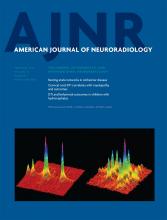Index by author
Jackson, G.D.
- PediatricsOpen AccessBilateral Posterior Periventricular Nodular Heterotopia: A Recognizable Cortical Malformation with a Spectrum of Associated Brain AbnormalitiesS.A. Mandelstam, R.J. Leventer, A. Sandow, G. McGillivray, M. van Kogelenberg, R. Guerrini, S. Robertson, S.F. Berkovic, G.D. Jackson and I.E. SchefferAmerican Journal of Neuroradiology February 2013, 34 (2) 432-438; DOI: https://doi.org/10.3174/ajnr.A3427
Jahan, R.
- NeurointerventionOpen AccessMiddle Cranial Fossa Sphenoidal Region Dural Arteriovenous Fistulas: Anatomic and Treatment ConsiderationsZ.-S. Shi, J. Ziegler, L. Feng, N.R. Gonzalez, S. Tateshima, R. Jahan, N.A. Martin, F. Viñuela and G.R. DuckwilerAmerican Journal of Neuroradiology February 2013, 34 (2) 373-380; DOI: https://doi.org/10.3174/ajnr.A3193
Johnson, C.E.
- EDITOR'S CHOICEBrainOpen AccessEvaluating CT Perfusion Using Outcome Measures of Delayed Cerebral Ischemia in Aneurysmal Subarachnoid HemorrhageP.C. Sanelli, N. Anumula, C.E. Johnson, J.P. Comunale, A.J. Tsiouris, H. Riina, A.Z. Segal, P.E. Stieg, R.D. Zimmerman and A.I. MushlinAmerican Journal of Neuroradiology February 2013, 34 (2) 292-298; DOI: https://doi.org/10.3174/ajnr.A3225
Ninety-six patients with SAH were evaluated with CT perfusion for cortical deficits and these were correlated with primary (permanent neurologic deficits and infarctions) and secondary (delayed cerebral ischemia manifesting as clinical deterioration) outcome measures. One-third of patients developed permanent neurologic deficits (78% showed CT perfusion defects), infarctions developed in 18% (88% had perfusion defects), and delayed cerebral ischemia was found in 50% (81% had perfusion defects). The most common perfusion abnormalities were reduced CBF and prolonged MTT.
Jones, B.V.
- PediatricsOpen AccessDiffusion Tensor Imaging Properties and Neurobehavioral Outcomes in Children with HydrocephalusW. Yuan, R.C. McKinstry, J.S. Shimony, M. Altaye, S.K. Powell, J.M. Phillips, D.D. Limbrick, S.K. Holland, B.V. Jones, A. Rajagopal, S. Simpson, D. Mercer and F.T. ManganoAmerican Journal of Neuroradiology February 2013, 34 (2) 439-445; DOI: https://doi.org/10.3174/ajnr.A3218
Jones, J.G.A.
- EDITOR'S CHOICESpineYou have accessDiffusion Tensor Imaging Correlates with the Clinical Assessment of Disease Severity in Cervical Spondylotic Myelopathy and Predicts Outcome following SurgeryJ.G.A. Jones, S.Y. Cen, R.M. Lebel, P.C. Hsieh and M. LawAmerican Journal of Neuroradiology February 2013, 34 (2) 471-478; DOI: https://doi.org/10.3174/ajnr.A3199
The relationship between DTI findings and clinical severity of cervical myelopathy due to spondylosis was studied in 30 patients. Low fractional anisotropy correlated with initial clinical assessments and patients with high FA showed better outcome. T2 signal intensity was associated with functional status but did not predict outcome whereas degree of stenosis lacked correlation with all clinical parameters. Thus, DTI may be a useful diagnostic tool for assessing disease severity in these patients and its predictive value regarding postoperative outcome may improve surgical decision making.
Jurcoane, A.
- BrainYou have accessThe U Sign: Tenth Landmark to the Central Region on Brain Surface Reformatted MR ImagingM. Wagner, A. Jurcoane and E. HattingenAmerican Journal of Neuroradiology February 2013, 34 (2) 323-326; DOI: https://doi.org/10.3174/ajnr.A3205
Kadirvel, R.
- Technical NoteOpen AccessCreation of Bifurcation-Type Elastase-Induced Aneurysms in RabbitsY.H. Ding, R. Kadirvel, D. Dai and D.F. KallmesAmerican Journal of Neuroradiology February 2013, 34 (2) E19-E21; DOI: https://doi.org/10.3174/ajnr.A2666
Kadziolka, K.
- NeurointerventionYou have accessMechanical Thrombectomy in Acute Stroke: Prospective Pilot Trial of the Solitaire FR Device while Under Conscious SedationS. Soize, K. Kadziolka, L. Estrade, I. Serre, S. Bakchine and L. PierotAmerican Journal of Neuroradiology February 2013, 34 (2) 360-365; DOI: https://doi.org/10.3174/ajnr.A3200
Kallmes, D.F.
- Technical NoteOpen AccessCreation of Bifurcation-Type Elastase-Induced Aneurysms in RabbitsY.H. Ding, R. Kadirvel, D. Dai and D.F. KallmesAmerican Journal of Neuroradiology February 2013, 34 (2) E19-E21; DOI: https://doi.org/10.3174/ajnr.A2666
- Review ArticlesOpen AccessReview of 2 Decades of Aneurysm-Recurrence Literature, Part 1: Reducing Recurrence after Endovascular CoilingE. Crobeddu, G. Lanzino, D.F. Kallmes and H.J. CloftAmerican Journal of Neuroradiology February 2013, 34 (2) 266-270; DOI: https://doi.org/10.3174/ajnr.A3032
Kelly, M.
- NeurointerventionYou have accessCanadian Experience with the Pipeline Embolization Device for Repair of Unruptured Intracranial AneurysmsC.J. O'Kelly, J. Spears, M. Chow, J. Wong, M. Boulton, A. Weill, R.A. Willinsky, M. Kelly and T.R. MarottaAmerican Journal of Neuroradiology February 2013, 34 (2) 381-387; DOI: https://doi.org/10.3174/ajnr.A3224
- EDITOR'S CHOICEExpedited PublicationYou have accessPipeline Embolization Device in Aneurysmal Subarachnoid HemorrhageJ.P. Cruz, C. O'Kelly, M. Kelly, J.H. Wong, W. Alshaya, A. Martin, J. Spears and T.R. MarottaAmerican Journal of Neuroradiology February 2013, 34 (2) 271-276; DOI: https://doi.org/10.3174/ajnr.A3380
The authors used the Pipeline device to treat 20 patients with acutely ruptured intracranial aneurysms. The most common types of aneurysms treated were blister and dysplastic/dissecting. Procedure-related morbidity/mortality overall was 15%, and 1 death directly related to the procedure occurred. Occlusion rates were 75% and 94% at 6 months and 12 months, respectively. The authors concluded that the Pipeline device offers a feasible treatment option in acute or subacute ruptured aneurysms, especially the blister type. Ruptured giant aneurysms remain challenging for both surgical and endovascular techniques; at this stage, the Pipeline device should be used with caution in this aneurysm subtype.








